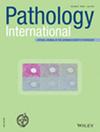可修改的小儿心脏瓣膜剥离技术可延长标本寿命,优化病理检查后的高级图像分析。
IF 2.5
4区 医学
Q2 PATHOLOGY
引用次数: 0
摘要
本文阐述了一种保留房室瓣和半月瓣及其他重要心脏结构的心脏瓣膜解剖技术。该技术最大限度地减少了对心脏标本的破坏,因此仍适合教学、演示和进一步研究。如果按照我们小组之前描述的灌注-张力固定法进行操作,该技术可以优化心脏标本的保存,以用于解剖后的教学和数字存档。本文章由计算机程序翻译,如有差异,请以英文原文为准。
A modifiable valve-sparing pediatric cardiac dissection technique promotes specimen longevity and optimizes advanced image analysis postpathological examination.
This paper illustrates a valve-sparing cardiac dissection technique that keeps the atrioventricular and semilunar valves and other important cardiac structures intact. The technique minimizes disruption in heart specimens, so they remain suitable for teaching, demonstration, and further research. When performed following the perfusion-distension method of fixation, as our group previously described, this technique could optimize the preservation of heart specimens for teaching and digital archiving postdissection.
求助全文
通过发布文献求助,成功后即可免费获取论文全文。
去求助
来源期刊

Pathology International
医学-病理学
CiteScore
4.50
自引率
4.50%
发文量
102
审稿时长
12 months
期刊介绍:
Pathology International is the official English journal of the Japanese Society of Pathology, publishing articles of excellence in human and experimental pathology. The Journal focuses on the morphological study of the disease process and/or mechanisms. For human pathology, morphological investigation receives priority but manuscripts describing the result of any ancillary methods (cellular, chemical, immunological and molecular biological) that complement the morphology are accepted. Manuscript on experimental pathology that approach pathologenesis or mechanisms of disease processes are expected to report on the data obtained from models using cellular, biochemical, molecular biological, animal, immunological or other methods in conjunction with morphology. Manuscripts that report data on laboratory medicine (clinical pathology) without significant morphological contribution are not accepted.
 求助内容:
求助内容: 应助结果提醒方式:
应助结果提醒方式:


